You searched for: Auschwitz
<< Previous | Displaying results 551-600 of 878 for "Auschwitz" | Next >>
-
Dr. Fritz Klein stands among corpses in a mass grave.
PhotoDr. Fritz Klein stands among corpses in a mass grave at Bergen-Belsen, after the liberation of the camp. He was required to assist in the burial of inmates who died there. Klein was a camp doctor at both Auschwitz and Bergen-Belsen. Germany, after April 15, 1945.

-
Partisan Groups in the Parczew Forests
ArticleArmed Jewish resistance began in Poland in 1942. Learn more about partisan activity in the Parczew forests during World War II.
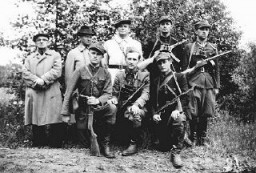
-
Janowska
ArticleIn 1941, the Nazis established Janowska camp. It was primarily used as a forced-labor and transit camp.
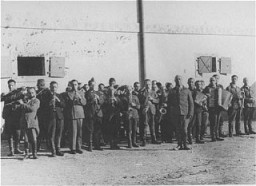
-
Luxembourg
ArticleBefore WWII, over 3,500 Jews lived in Luxembourg. Under the German occupation, this community was almost completely destroyed. Learn more.
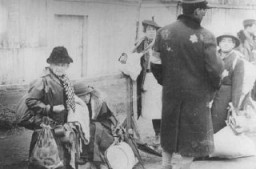
-
Breendonk
ArticleThe Germans established the Breendonk internment camp in a fortress near Antwerp, Belgium. Hundreds of people died there by torture, executions, and harsh conditions.
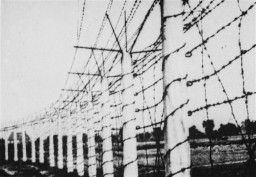
-
Cookbooks and Recipes
ArticleEach cookbook or recipe in the Museum’s collection tells a story. Learn more about the significance of these documents during the Holocaust.
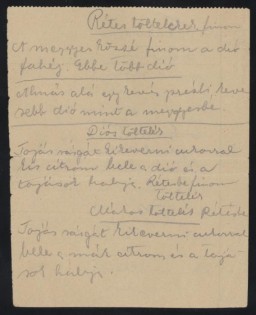
-
The Role of Academics and Teachers
ArticleTo implement their policies, the Nazis had help from individuals across Europe, including professionals in many fields. Learn about the role of academics and teachers.
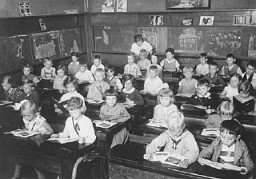
-
Forced labor at a Siemens factory
PhotoPrisoners at forced labor building airplane parts at the Siemens factory in the Bobrek labor camp, a subcamp of Auschwitz. February-June 1944. David Stein is pictured in the row to the right, with his back to the camera; his brother Charles is in the same row, fourth from the left, facing the camera.

-
The Fink family in Westerbork
PhotoMichael Fink and his parents Manfred and Herta in the Westerbork camp, 1941–1944. Westerbork's primary role was as a transit camp. However, there was also a long-term camp population there. The Finks were among these residents. The family was in Westerbork until the spring of 1944, when they were deported to Theresienstadt. Michael and Herta survived, but Manfred was killed after being deported to Auschwitz-Birkenau and other concentration camps.
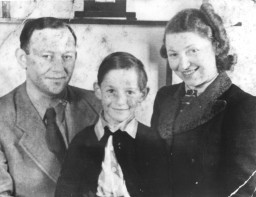
-
Prewar portrait of Dorrith Oppenheim
PhotoDorrith was born in Kassel, Germany, in December 1938. Her parents were Hans and Trudi Oppenheim. Following increased anti-Jewish measures, Dorrith was among the children sent on Kindertransports to find refuge in the United Kingdom. She left Germany on July 24, 1939. She never saw her parents again. They were deported to Auschwitz, where they perished in October 1944.
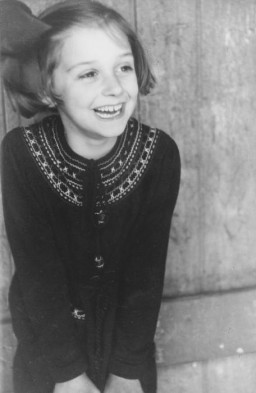
-
Romani (Gypsy) children used in racial studies
FilmEva Justin was an assistant to Dr. Robert Ritter, the Third Reich's "expert" on Roma (Gypsies). She studied these Romani (Gypsy) children as part of her dissertation on the racial characteristics of Roma. The children stayed at St. Josefspflege, a Catholic children's home in Mulfingen, Germany. Justin completed her study shortly after this film was taken. The children were deported to Auschwitz-Birkenau, where most were killed.
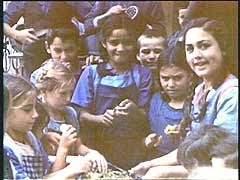
-
Family portrait in Munkacs
PhotoPortrait of the Ehrlich family seated around the family table. Munkacs, Czechoslovakia, 1930. Among those pictured is Elizabeth Ehrlich (later Roth) standing in the middle of the back row in a light dress, and Rella Ehrlich (front row, second from the right). Elizabeth was born in Munkacs. In 1944 she was confined to the ghetto there before being deported with her family to Auschwitz. She was later transferred to a camp in Bydogszcz, Poland, and from there to the Stutthof concentration camp.
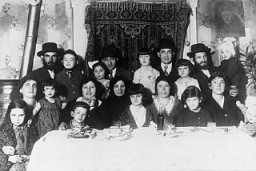
-
Sisters Eva and Liane Münzer
PhotoSisters Eva and Liane Münzer. They were placed in hiding with a devout Catholic couple. In 1944, Eva and Liane were reported to the police as a result of a fight between their rescuers. The husband denounced his wife and the two Jewish girls. The three were immediately arrested and sent to the Westerbork camp. On February 8, 1944, eight- and six-year-old Eva and Liane were deported to Auschwitz, where they were murdered. Photograph taken in The Hague, the Netherlands, 1940.
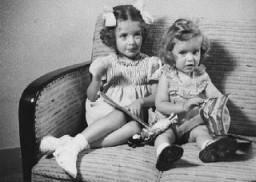
-
A rescuer family with Jewish children they sheltered
PhotoThe Anciaux family with Annie and Charles Klein (front), Jewish children whom they sheltered during the war. Brussels, Belgium, between 1943 and 1945. Carle Enelow and Yettanda Stewart (born Charles and Annie Klein) were Jewish siblings who were hidden during the war by the family of Emile Anciaux, a Belgian Catholic. Charles and Annie's parents were deported from Mechelen (Malines) to Auschwitz, where they were murdered (their father on October 31, 1942, and their mother on January 15, 1944). After the…

-
Père Jacques de Jésus (born Lucien Bunel)
PhotoPère Jacques de Jésus (born Lucien Bunel) was a Carmelite headmaster of a Catholic boys school in Avon, France. Angered at Nazi policies, he made his school a refuge for young men seeking to avoid forced labor and for Jews. On January 15, 1944, the Gestapo raided the school, seizing Père Jacques and three Jewish children. The boys were deported to Auschwitz and killed. Père Jacques, sent to various concentration camps, died shortly after liberation.
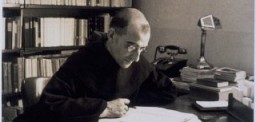
-
Close-up portrait of Hebrew and Yiddish author Itzhak Katzenelson in the Vittel internment camp
PhotoClose-up portrait of Hebrew and Yiddish author Itzhak Katzenelson in the Vittel internment camp. Because he possessed a Honduran passport, Katzenelson and his son were sent to the Vittel internment camp in France. They remained there for a year, during which time Katzenelson continued to write. In April 1944, however, both were deported to their death in Auschwitz. Vittel, France, 1943-1944.
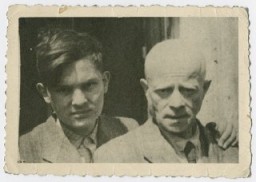
-
Natzweiler-Struthof
ArticleThe Nazis opened the Natzweiler-Struthof concentration camp in 1941. Learn more about the camp, its prisoners, and forced labor and medical experiments.
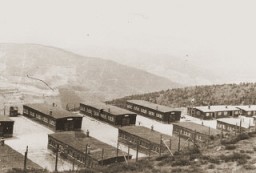
-
Paris
ArticleNazi Germany invaded Paris in May, 1940. Learn more about Paris during World War II and the fate of the Jewish population.
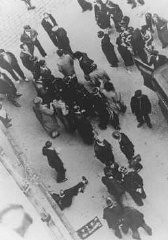
-
Sephardi Jews during the Holocaust
ArticleLearn about the fate of Sephardi Jewish communities during the Holocaust. On the eve of WWII, Europe's Sephardi Jews lived mostly in the Balkan countries.
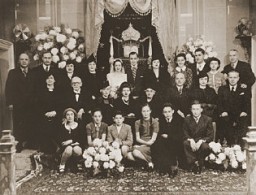
-
Silvio Ortona
ArticleRead the Jewish Partisan Educational Foundation's short biography of Silvio Ortona.

-
Meir Porges
ArticleRead the Jewish Partisan Educational Foundation's short biography of Meir Porges.
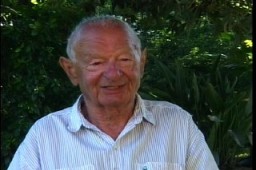
-
The Role of Business Elites
ArticleTo implement their policies, the Nazis had help from individuals across Europe, including professionals in many fields. Learn about the role of business elites.

-
Father Jacques
ArticleFather Jacques (Lucien Bunel) provided refuge to Jews and others at a school in Avon, France. Imprisoned in several Nazi camps for his activities, he died soon after liberation.

-
Harry Burger
ArticleRead the Jewish Partisan Educational Foundation's short biography of Harry Burger.
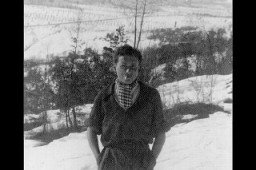
-
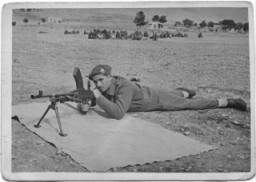
-
Miles Lerman (Jewish Partisan Educational Foundation biography)
ArticleRead the Jewish Partisan Educational Foundation's short biography of Miles Lerman.
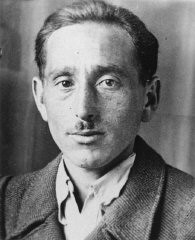
-
Liquidation of the Krakow Ghetto
Timeline EventMarch 13-16, 1943. On this date, SS and police authorities liquidated the Krakow ghetto.
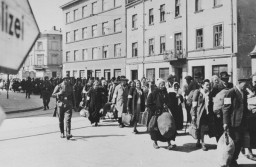
-
Norbert Wollheim describes departure of Kindertransporte (Childrens' Transports) from Berlin, and the separation of children from their parents
Oral HistoryNorbert studied law and was a social worker in Berlin. He worked on the Kindertransport (Children's Transport) program, arranging to send Jewish children from Europe to Great Britain. His parents, who also lived in Berlin, were deported in December 1942. Norbert, his wife, and their child were deported to Auschwitz in March 1943. He was separated from his wife and child, and sent to the Buna works near Auschwitz III (Monowitz) for forced labor. Norbert survived the Auschwitz camp, and was liberated by US…
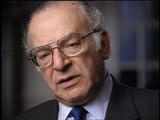
-
Norbert Wollheim describes a roundup of Jews in Berlin
Oral HistoryNorbert studied law and was a social worker in Berlin. He worked on the Kindertransport (Children's Transport) program, arranging to send Jewish children from Europe to Great Britain. His parents, who also lived in Berlin, were deported in December 1942. Norbert, his wife, and their child were deported to Auschwitz in March 1943. He was separated from his wife and child, and sent to the Buna works near Auschwitz III (Monowitz) for forced labor. Norbert survived the Auschwitz camp, and was liberated by US…

-
Norbert Wollheim describes deportation from Berlin
Oral HistoryNorbert studied law and was a social worker in Berlin. He worked on the Kindertransport (Children's Transport) program, arranging to send Jewish children from Europe to Great Britain. His parents, who also lived in Berlin, were deported in December 1942. Norbert, his wife, and their child were deported to Auschwitz in March 1943. He was separated from his wife and child, and sent to the Buna works near Auschwitz III (Monowitz) for forced labor. Norbert survived the Auschwitz camp, and was liberated by US…
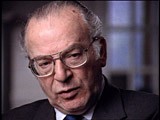
-
Thomas Buergenthal describes an emigration operation in an orphanage in postwar Germany
Oral HistoryThomas's family moved to Zilina in 1938. As the Slovak Hlinka Guard increased its harassment of Jews, the family decided to leave. Thomas and his family ultimately entered Poland, but the German invasion in September 1939 prevented them from leaving for Great Britain. The family ended up in Kielce, where a ghetto was established in April 1941. When the Kielce ghetto was liquidated in August 1942, Thomas and his family avoided the deportations to Treblinka that occurred in the same month. They were sent…

-
Norbert Wollheim describes his liberation at Schwerin, in northeast Germany, in May 1945
Oral HistoryNorbert studied law and was a social worker in Berlin. He worked on the Kindertransport (Children's Transport) program, arranging to send Jewish children from Europe to Great Britain. His parents, who also lived in Berlin, were deported in December 1942. Norbert, his wife, and their child were deported to Auschwitz in March 1943. He was separated from his wife and child, and sent to the Buna works near Auschwitz III (Monowitz) for forced labor. Norbert survived the Auschwitz camp, and was liberated by US…
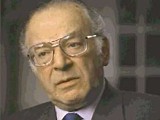
-
Norbert Wollheim describes forced labor at the Buna works
Oral HistoryNorbert studied law and was a social worker in Berlin. He worked on the Kindertransport (Children's Transport) program, arranging to send Jewish children from Europe to Great Britain. His parents, who also lived in Berlin, were deported in December 1942. Norbert, his wife, and their child were deported to Auschwitz in March 1943. He was separated from his wife and child, and sent to the Buna works near Auschwitz III (Monowitz) for forced labor. Norbert survived the Auschwitz camp, and was liberated by US…
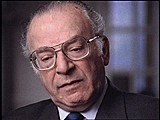
-
Neuengamme
ArticleIn 1938, the Nazis established Neuengamme concentration camp. Learn more about camp conditions, medical experiments, and liberation.

-
Sighet
ArticleLearn about the history of Sighet, birthplace of Elie Wiesel. The Jewish population of Sighet was deported to Auschwitz in May 1944. Most of the deportees were gassed on arrival.
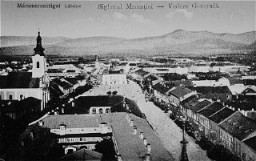
-
Mittelbau Main Camp: In Depth
ArticleLearn about conditions and forced labor in Dora-Mittelbau, the center of an extensive network of forced-labor camps for the production of V-2 missiles and other weapons.

-
Herzogenbusch Main Camp (Vught)
ArticleThe Herzogenbusch concentration camp in the Netherlands began functioning in January 1943. Learn about its establishment, administration, prisoners, and conditions there.

-
Welek Luksenburg
ID CardWelek grew up in Dabrowa Gornicza, an industrial town in western Poland. His father, Simcha, was a wholesale meat merchant and his mother, Rozalia, served as president of the local chapter of the Women's International Zionist Organization. Welek's older brother, Szlomo, was a dentist. The Luksenburgs were among the several thousand Jews who lived in Dabrowa Gornicza. 1933–39: Like many other children in the town, Welek attended public school. Because his family was very religious, he did not attend…

-
Hans (John) Sachs
ID CardHans was born to a Jewish family in the Sudetenland, a region of Czechoslovakia that had a large German population. In 1922 the Sachs family moved to Vienna, Austria, where they purchased a dry goods store. Hans attended public school and had many non-Jewish friends. 1933–39: By 1936 many of Hans' friends and their families supported the Nazi movement. In March 1938, German troops entered Austria and incorporated it into the Reich. Hans watched as large crowds in Vienna cheered Hitler when he visited…
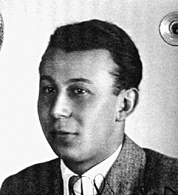
-
Magda Rein
ID CardMagda was the oldest of two children born to observant Jewish parents. They lived in Satoraljaujhely, a town in northeastern Hungary on the Czechoslovakian border. Jews represented some 20 percent of the town's approximately 18,000 persons. Magda's father owned a bakery; her mother was a midwife. 1933-39: At 10 years of age, Magda began accompanying her mother when she attended to births nearby. Her mother helped all women--Jews, Roma (Gypsies) and peasants in the surrounding villages. When Magda was 12,…

-
Lisl Winternitz
ID CardLisl was the youngest of two children born to a Jewish family in the Czechoslovakian capital of Prague, a city with a Jewish community that dated back to the eleventh century. Lisl's family lived on Karlova Street in the Karlin district of the city. Lisl's father owned a wholesale business that sold floor coverings. 1933-39: Lisl was 12 when, on March 15, 1939, the German occupation forces entered Prague. She went to school that day and a teacher shouted at her, "You dirty, filthy Jew," and then spat in…
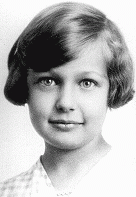
-
Herman Klein
ID CardHerman was the fourth of eight children born to a religious Jewish family in the small town of Sirma, located near the city of Sevlus. The Kleins had a small plot of land, which they farmed, and they also ran a shoe shop. At age four Herman began attending religious school. When he started public elementary school, he continued his religious lessons in the afternoons. 1933-39: In March 1939, the region of Czechoslovakia in which Herman lived was annexed to Hungary. His teacher at school was replaced by a…
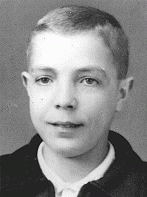
-
Gyula (Gyuszi) Brieger
ID CardGyula was also known as Gyuszi. He was born into a large religious Jewish family in the village of Nagyhalasz in northeastern Hungary. The Briegers spoke both Yiddish and Hungarian. After Gyula's mother died, his father remarried and the family moved to the town of Nyiregyhaza, where his father owned and operated a hardware store. Nyiregyhaza had a Jewish population of 5,000. 1933-39: Gyula was the second oldest son in a household of seven children. Nyiregyhaza was a rural town in which people still used…
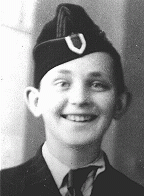
-
Jozef Tiso
ArticleJozef Tiso was a Slovak politician and a Roman Catholic priest. From 1939 to 1945, he was the president of the Slovak Republic, one of Nazi Germany’s allies.
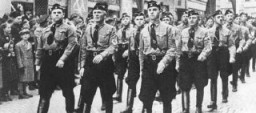
-
Siegfried Halbreich describes arrival at and brutality in the Gross-Rosen camp
Oral HistoryAfter Germany invaded Poland on September 1, 1939, Siegfried fled with a friend. They attempted to get papers allowing them to go to France, but were turned over to the Germans. Siegfried was jailed, taken to Berlin, and then transported to the Sachsenhausen camp near Berlin in October 1939. He was among the first Polish Jews imprisoned in Sachsenhausen. Inmates were mistreated and made to carry out forced labor. After two years, Siegfried was deported to the Gross-Rosen concentration camp, where he was…
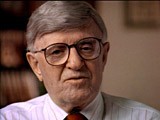
-
Siegfried Halbreich describes conditions in the Sachsenhausen camp
Oral HistoryAfter Germany invaded Poland on September 1, 1939, Siegfried fled with a friend. They attempted to get papers allowing them to go to France, but were turned over to the Germans. Siegfried was jailed, taken to Berlin, and then transported to the Sachsenhausen camp near Berlin in October 1939. He was among the first Polish Jews imprisoned in Sachsenhausen. Inmates were mistreated and made to carry out forced labor. After two years, Siegfried was deported to the Gross-Rosen concentration camp, where he was…
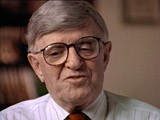
-
Sam Spiegel describes life in a displaced persons camp
Oral HistoryIn 1942, Sam was forced into a ghetto in his hometown and assigned to work in a munitions factory. In 1944 he was transported to Auschwitz and then forced to work in a train factory. He survived eight days on a death march after the evacuation of Auschwitz by the Nazis. He was liberated by Soviet units in January 1945. He lived in a displaced persons camp in Germany where worked for the United Nations Relief and Rehabilitation Administration. In 1947, he immigrated to the United States.
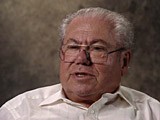
-
Madeline Deutsch describes the sacrifices her mother made to help her survive
Oral HistoryMadeline was born into a middle class family in an area of Czechoslovakia that was annexed by Hungary in 1938-1939. Her father worked out of their home and her mother was a homemaker. Madeline attended high school. In April 1944 her family was forced into a Hungarian ghetto. The family lived in the ghetto for two weeks before being transported to Auschwitz. Madeline and her mother were separated from her father and older brother. Neither her father nor brother survived the war. A week after arriving in…

-
Morris Kornberg describes forced labor beginning after the German invasion of Poland
Oral HistoryMorris grew up in a very religious Jewish household and was active in a Zionist sports league. When the Germans invaded Poland in September 1939, Morris's town was severely damaged. Morris's family was forced to live in a ghetto, and Morris was assigned to forced labor. After a period of imprisonment in Konskie, a town about 30 miles from Przedborz, Morris was deported to the Auschwitz camp. He was assigned to the Jawischowitz subcamp of Auschwitz. In January 1945, Morris was forced on a death march and…

-
Sam Spiegel describes conditions in a forced-labor camp
Oral HistoryIn 1942, Sam was forced into a ghetto in his hometown and assigned to work in a munitions factory. In 1944 he was transported to Auschwitz and then forced to work in a train factory. He survived eight days on a death march after the evacuation of Auschwitz by the Nazis. He was liberated by Soviet units in January 1945. He lived in a displaced persons camp in Germany where worked for the United Nations Relief and Rehabilitation Administration. In 1947, he immigrated to the United States.

